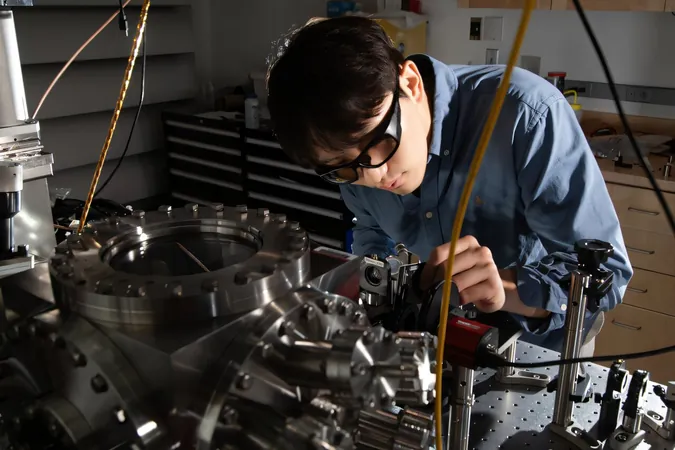
Unlocking the Quantum Mystery of Gravity: Laser Cooling Breakthrough
2025-05-21
Author: Charlotte
Is Gravity Quantum? The Eternal Question
One of the most tantalizing enigmas in modern physics revolves around the question: "Is gravity quantum?" While the electromagnetic, weak, and strong forces have clear quantum theories, gravity remains an elusive challenge without a comprehensive quantum framework.
As Ph.D. candidate Dongchel Shin from MIT's Mechanical Engineering department explains, numerous theories exist, ranging from gravity being purely classical to fully quantum. Yet, the crux of the issue is that experimental verification has long been out of reach.
Revolutionary Research in Torsional Oscillators
Shin, also a MathWorks Fellow, is at the forefront of this mystery with a pioneering study that showcases laser cooling of a centimeter-long torsional oscillator. Recently published in Optica, this groundbreaking work may pave the way to experiments that could unveil the quantum nature of gravity.
Traditionally, laser cooling has cooled atomic gases since the 1980s and has been utilized for nanoscale mechanical oscillators since 2010. Now, for the first time, this technique has been applied to torsional oscillators, crucial for global gravity research.
Torsion Pendulums: An Age-Old Tool in Gravity Research
Torsion pendulums have a rich history in gravitational studies since Henry Cavendish's iconic 1798 experiment. These devices have been instrumental in measuring Newton’s gravitational constant and exploring new gravitational phenomena. Shin's research merges atomic and torsional oscillator technology for groundbreaking insights.
The researchers demonstrated the cooling of a centimeter-scale torsional oscillator from room temperature to a frigid 10 millikelvins (1/1,000th of a kelvin) through innovative optical techniques.
Precision Measurement Techniques
Shin elaborates on their cutting-edge methods: "An optical lever is used to shift a laser beam projected on a mirror, translating microscopic movements into measurable signals. However, disturbances like air currents can mimic real signals and obscure the data we need."
Their ingenious solution involved using a second mirrored laser beam to negate these disturbances, resulting in reduced noise levels and allowing the team to observe movements with extraordinary precision—up to ten times better than the oscillator's own quantum fluctuations. This impressive sensitivity enabled cooling to an astounding 10 milli-kelvins.
A Path to Quantum States
Shin and his team are only scratching the surface of their capabilities. While they've reached quantum-limited precision, their ultimate goal lies in achieving the quantum ground state. "To realize this, we will amplify the optical interaction or employ optical trapping strategies, which could lead to groundbreaking experiments to test whether gravity operates at quantum levels," says Shin.
Collaborative Efforts and Interdisciplinary Insight
Alongside Shin, other key contributors from MIT and the University of Utah, including Vivishek Sudhir and Dylan Fife, add depth to this research. Shin reflects on the interdisciplinary nature of their work: "Tackling the quantum aspects of gravity requires a multifaceted understanding of physics, state-of-the-art technology, and practical engineering skills. My background in mechanical engineering uniquely positions me to integrate these diverse disciplines."
This collaborative effort promises not only to deepen our understanding of gravity but could also answer one of science’s most profound questions: Is gravity a quantum phenomenon? The future of this research is undeniably exciting.









 Brasil (PT)
Brasil (PT)
 Canada (EN)
Canada (EN)
 Chile (ES)
Chile (ES)
 Česko (CS)
Česko (CS)
 대한민국 (KO)
대한민국 (KO)
 España (ES)
España (ES)
 France (FR)
France (FR)
 Hong Kong (EN)
Hong Kong (EN)
 Italia (IT)
Italia (IT)
 日本 (JA)
日本 (JA)
 Magyarország (HU)
Magyarország (HU)
 Norge (NO)
Norge (NO)
 Polska (PL)
Polska (PL)
 Schweiz (DE)
Schweiz (DE)
 Singapore (EN)
Singapore (EN)
 Sverige (SV)
Sverige (SV)
 Suomi (FI)
Suomi (FI)
 Türkiye (TR)
Türkiye (TR)
 الإمارات العربية المتحدة (AR)
الإمارات العربية المتحدة (AR)